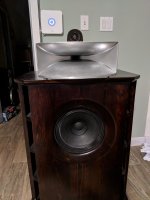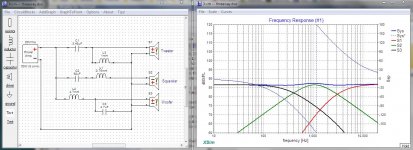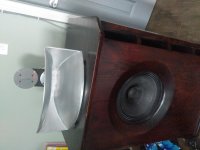Hi I'm a noob when it comes to crossover designs, I currently built a speaker system, using a 12" fullrange driver 8ohm, a compression horn rated at 20ohm, and a tweeter rated at 4 ohm, for the horn I have a 1uf cap, and for the tweeter a 2uf cap, I'm wondering why is it that when I have the capacitors in the circuit and check the overall ohms with my multimeter it only seems the full ranges 8ohms impedence and not the other 2? Also what is the best way to connect these all together?parallel? Series? Or mixing both?
I'm connecting them to a 8ohm tube amplifier, sounds amazing But don't know if I have them connected correct am afraid I will ruin amp.. any help will be very much appreciated
I'm connecting them to a 8ohm tube amplifier, sounds amazing But don't know if I have them connected correct am afraid I will ruin amp.. any help will be very much appreciated
Attachments
A meter only tests for DC resistance, not AC impedance.
The horn needs a second order high pass (a series C and a shunt L), instead
of the first order (just a series C). This system should be a parallel crossover,
each driver and its crossover components go separately to the amplifier.
The horn needs a second order high pass (a series C and a shunt L), instead
of the first order (just a series C). This system should be a parallel crossover,
each driver and its crossover components go separately to the amplifier.
Last edited:
Hi I'm a noob when it comes to crossover designs, I currently built a speaker system, using a 12" fullrange driver 8ohm, a compression horn rated at 20ohm, and a tweeter rated at 4 ohm, for the horn I have a 1uf cap, and for the tweeter a 2uf cap, I'm wondering why is it that when I have the capacitors in the circuit and check the overall ohms with my multimeter it only seems the full ranges 8ohms impedence and not the other 2? Also what is the best way to connect these all together?parallel? Series? Or mixing both?
I'm connecting them to a 8ohm tube amplifier, sounds amazing But don't know if I have them connected correct am afraid I will ruin amp.. any help will be very much appreciated
With just caps, your woofer is going full range, so when you probe it with your meter you are reading only it's dc resistance. You can't read DC resistance through a capacitor.
If you are just using capacitors for the squawker and tweeter the bass driver is being driven full range which is probably less than optimal.
Get a copy of XSIM (which is free) so that you can model your system. Given the size and types of your drivers, I'm betting a simple second order crossover would do the job. See the thumbnail for a starting point design (part values approximate). You can download the DXO file and use the simulator to manipulate the part values to get the crossover points you need.
Tip: keep the parts connected across the speakers as low value as you can to get a good result.
Then after an experimental build, you can use Room EQ Wizard to make audible measurements and fine tune your design.
Attachments
Last edited:
If I have them connected as it is, and the full range driver is 8oh., Horn tweeter is 20ohm with a 1uf cap, and tweeter is 4ohm with 2uf cap, and they are all hooked up parallel and the I connect it to my amp, what will the ohm load be? Since my amp is a tube amp and is only rated at 8phm, is it safe to keep it hooked up as it is? What's most important I'm trying to figure out with the way it is hooked up now, and the woofer is in fact a full range driver and the reasoning I did not cut off any frequencies from it is it only goes to 15000-1600hz ,my question is trying to figure out what the ohm load with it being all connected in parallel, would be since I cannot test it with a multimeter, I want to know if it is safe to hook up to my 8ohm amp, I already have but .wondering if it poses any harm to my 8ohm tube amp...thanks for the replies I appreciate it greatly
A meter only tests for DC resistance, not AC impedance.
The horn needs a second order high pass (a series C and a shunt L), instead
of the first order (just a series C). This system should be a parallel crossover,
each driver and its crossover components go separately to the amplifier.
What does a shunt regulator do, why is it needed for.the horn? I am just trying to get as much information as I can since I value it so much, but am trying to figure it out in my head..
With just caps, your woofer is going full range, so when you probe it with your meter you are reading only it's dc resistance. You can't read DC resistance through a capacitor.
If you are just using capacitors for the squawker and tweeter the bass driver is being driven full range which is probably less than optimal.
Get a copy of XSIM (which is free) so that you can model your system. Given the size and types of your drivers, I'm betting a simple second order crossover would do the job. See the thumbnail for a starting point design (part values approximate). You can download the DXO file and use the simulator to manipulate the part values to get the crossover points you need.
Tip: keep the parts connected across the speakers as low value as you can to get a good result.
Then after an experimental build, you can use Room EQ Wizard to make audible measurements and fine tune your design.
Tweeters are 4ohm
The horns are rated 630 Hz - 12500 Hz 20ohm
and woofer/full range drivers are rated 40Hz-16000Hz 8ohm
Is the way you have it modeled take into consideration to make them work for the 8ohm amp? Is that why you have them modeled some in series and some in parallel.
Taking these into consideration can you pls model it again? I'm trying to download the program but my phone cannot open that file. I appreciate your help greatly
If you can name make and model of each unit, perhaps someone could simulate impedance profile.
Tweeter is :4ohm emit ribbon tweeter
Horn is Russian lomo 1a20 20ohm Frequency range: 630 Hz - 12500 Hz 12watt
Bigger woofer is also a Russian Lomo 4a32 full range driver they used to be 16ohm, I had them rewound and they are now 8ohm impedence 40-16000hz also 12 watt 95db
Attachments
if the Russian Lomo 4a32 are truly 40-16000hz ( that's 16khz) why do you need the mid horn and tweeter?(tweeter maybe...)
the caps only x-over arrangement is going to result in a stepped response that would be shrill to listen to.
nothing you've done so far will hurt your amp.
this may be helpful to your quest and answer some of your questions Introduction to designing crossovers without measurement
the caps only x-over arrangement is going to result in a stepped response that would be shrill to listen to.
nothing you've done so far will hurt your amp.
this may be helpful to your quest and answer some of your questions Introduction to designing crossovers without measurement
Last edited:
Tweeters are 4ohm
The horns are rated 630 Hz - 12500 Hz 20ohm
and woofer/full range drivers are rated 40Hz-16000Hz 8ohm
Is the way you have it modeled take into consideration to make them work for the 8ohm amp? Is that why you have them modeled some in series and some in parallel.
Taking these into consideration can you pls model it again? I'm trying to download the program but my phone cannot open that file. I appreciate your help greatly
Neither XSim nor REW are phone apps. These are PC programs that need windows to run.
The model is for a pretty standard 2nd order 3 way crossover. The software makes it easy to adjust the part values to move your crossover points.
I notice that your woofer appears to have a "whizzer" cone in the centre to handle treble and you say it goes out to 16,000 hz, so it's a full range driver. This is very likely to interfere with any sensible crossover design and could be very difficult to compensate for.
You're also going to run into some problems with the mixed impedance and you may have to attenuate some parts to get it working right... but, without the exact speaker specifications, you won't know that until you do an experimental build and test it.
In your place, I think I would go with the full range driver in the cabinet and perhaps add a small horn super-tweeter on top, rather than trying to treat it as a woofer. The super-tweeter would most likely be perfectly happy with a simple capacitor crossover.
if the Russian Lomo 4a32 are truly 40-16000hz ( that's 16khz) why do you need the mid horn and tweeter?(tweeter maybe...)
the caps only x-over arrangement is going to result in a stepped response that would be shrill to listen to.
nothing you've done so far will hurt your amp.
this may be helpful to your quest and answer some of your questions Introduction to designing crossovers without measurement
But doesnt connecting 20ohm, 8ohm, and 4ohm In parallel give me 2ohm... Which is ok for a 8ohm tu e amp? Should I try connecting so e in series and so me I parallel to get a total closer to 8ohm I stead of the current 2ohm?
But doesnt connecting 20ohm, 8ohm, and 4ohm In parallel give me 2ohm... Which is ok for a 8ohm tu e amp? Should I try connecting so e in series and so me I parallel to get a total closer to 8ohm I stead of the current 2ohm?
Nope. At bass frequencies you'll have 8 ohms, when the first cap cuts in you'll have 20 in parallel with 8 which is 5 ohms, then the third one starts working you'll end up with 20 | 8 | 4 which is 2.35 ohms.
If you hook them all up in series, you will lose all bass to the capacitors.
As Allen points out a crossover network isolates them to prevent this.
Also please be aware that the impedance specification of speakers is "nominal", the actual impedance by measurement is going to vary over quite a wide range according to frequency.
Last edited:
I want to know if it is safe to hook up to my 8ohm amp, I already have but .wondering if it poses any harm to my 8ohm tube amp...thanks for the replies I appreciate it greatly
I wouldn't do it. Tube amps can be very finicky about loading and you could end up damaging either the output transformer or the power tubes.
Lets back up a bit ...
Why are you trying to make this work?
Is there a sound quality problem you're trying to solve?
Hopefully you're not doing this simply because it looks cool. In that case I'd just set everything there and not hook it up.
I wouldn't do it. Tube amps can be very finicky about loading and you could end up damaging either the output transformer or the power tubes.
Lets back up a bit ...
Why are you trying to make this work?
Is there a sound quality problem you're trying to solve?
Hopefully you're not doing this simply because it looks cool. In that case I'd just set everything there and not hook it up.
No I just think it sounds better, the horn Adda something that the full range driver can't do..then when I added the ribbon tweeter it just sings!! String instruments just sparkle in the air, I love the way they all sound together, that's why. But was afraid that if I hooked them up in parallel I get 2.3ohms, and some people said it was okay, and some said it's not including yourself, I could connect 2 of them in series and then again to the 3rd one I parallel to get a total of close to 8ohms.
I could connect 8ohm full range with 4 ohm tweeter in series to get 12ohms, and the again those 2 in parallel with the 20ohm horn to get 7.5ohms which is close to 8ohms... Should I do that Instead or just leave them as is connected in parallel
4ohm, tweeter
8ohm full range
20ohm horn
To get a total of 2.3ohms... just to clarify what some of the way more knowledgeable gentlemen out there said that is safe for my 8ohm tube amp?
Nope. At bass frequencies you'll have 8 ohms, when the first cap cuts in you'll have 20 in parallel with 8 which is 5 ohms, then the third one starts working you'll end up with 20 | 8 | 4 which is 2.35 ohms.
If you hook them all up in series, you will lose all bass to the capacitors.
As Allen points out a crossover network isolates them to prevent this.
Also please be aware that the impedance specification of speakers is "nominal", the actual impedance by measurement is going to vary over quite a wide range according to frequency.
At which frequencies would you cut highs and lows for each of the drivers?
Many tube amps would prefer not to have a large impedance load, but the best reason to be careful when connecting it is because you need to understand the speaker first, so you know what you are connecting.I could connect 8ohm full range with 4 ohm tweeter in series to get 12ohms, and the again those 2 in parallel with the 20ohm horn to get 7.5ohms which is close to 8ohms... Should I do that Instead or just leave them as is connected in parallel
You cannot add impedances like you are doing, it makes no sense and is wrong.
- Status
- This old topic is closed. If you want to reopen this topic, contact a moderator using the "Report Post" button.
- Home
- Loudspeakers
- Multi-Way
- Crossover design question


